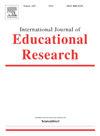The perceived relationship between self-directed learning, active learning, and critical thinking in using GenAI of adult learners in Ghana: An assessment of Gen Z, Millennials, GenX, and Baby Boomers
IF 2.5
3区 教育学
Q1 EDUCATION & EDUCATIONAL RESEARCH
引用次数: 0
Abstract
Generative AI (GenAI) is believed to support generational learning. However, there is no single study that examines the use of GenAI for self-directed learning (SDL), active learning (AL), and critical thinking (CT) of different cohorts of adult learners. Specifically, in the field of adult education, there are limited studies on the effect of GenAI on teaching and learning. This study employs a cross-sectional quantitative design to examine the relationships between SDL, AL, and CT in the context of adult learners' use of GenAI tools like ChatGPT. It considers how demographic variables moderate these relationships. The study was underpinned by the SDL theory by Tough in 1971. An analysis of 281 survey responses of adult learners grouped by generation from five (5) adult higher education institutions in Ghana was performed using descriptive statistics, ANOVA (analysis of variance), and SEM (structural equation modeling). The study’s findings indicate that GenAI is perceived as having a significant positive effect on the SDL, AL, and CT of adult learners. A significant positive interrelationship was observed between SDL, AL, and CT. Demographic factors involving gender, year born (generational group), education level, and mode of learning had a perceived significant positive effect on SDL, AL, and CT. Notably, no statistical mean differences were found in the use of GenAI for SDL, AL, and CT across generational groups. The findings advocate for the effective adoption of GenAI to foster lifelong learning among adult learners. Developers of learning technologies and higher education leaders should ensure an inclusive GenAI design.
加纳成人学习者使用GenAI时自主学习、主动学习和批判性思维之间的关系:对Z世代、千禧一代、x世代和婴儿潮一代的评估
生成式人工智能(GenAI)被认为支持代际学习。然而,目前还没有一项研究考察GenAI在不同成年学习者群体的自主学习(SDL)、主动学习(AL)和批判性思维(CT)中的应用。具体而言,在成人教育领域,关于GenAI对教与学的影响的研究有限。本研究采用横断面定量设计,在成人学习者使用ChatGPT等GenAI工具的背景下,研究SDL、人工智能和CT之间的关系。它考虑了人口变量如何调节这些关系。这项研究得到了1971年由Tough提出的SDL理论的支持。采用描述性统计、方差分析(ANOVA)和结构方程模型(SEM)对加纳五(5)所成人高等教育机构按世代分组的281名成人学习者的调查反馈进行了分析。研究结果表明,GenAI被认为对成人学习者的SDL、AL和CT有显著的积极影响。SDL、AL与CT呈显著正相关。包括性别、出生年份(代际组)、教育水平和学习方式在内的人口统计学因素对SDL、AL和CT有显著的正向影响。值得注意的是,在SDL、AL和CT中GenAI的使用在不同代际组中没有统计学上的平均差异。研究结果提倡有效地采用GenAI来促进成人学习者的终身学习。学习技术的开发者和高等教育的领导者应该确保一个包容性的GenAI设计。
本文章由计算机程序翻译,如有差异,请以英文原文为准。
求助全文
约1分钟内获得全文
求助全文
来源期刊

International Journal of Educational Research
EDUCATION & EDUCATIONAL RESEARCH-
CiteScore
6.20
自引率
3.10%
发文量
141
审稿时长
21 days
期刊介绍:
The International Journal of Educational Research publishes regular papers and special issues on specific topics of interest to international audiences of educational researchers. Examples of recent Special Issues published in the journal illustrate the breadth of topics that have be included in the journal: Students Perspectives on Learning Environments, Social, Motivational and Emotional Aspects of Learning Disabilities, Epistemological Beliefs and Domain, Analyzing Mathematics Classroom Cultures and Practices, and Music Education: A site for collaborative creativity.
 求助内容:
求助内容: 应助结果提醒方式:
应助结果提醒方式:


